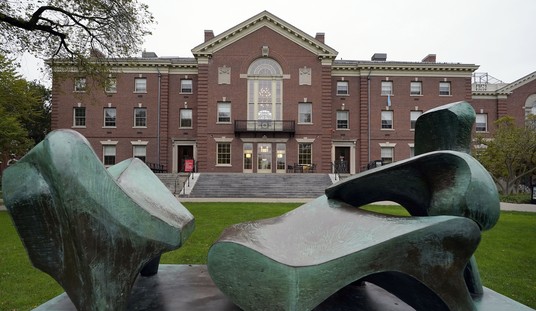Yesterday, David Brooks scolded Republicans for not listening to “intellectual authorities” on fiscal policy. Fair enough; I figured I’d devote some time today to the opinion of intellectual authorities on economics and public policy, and decided to focus on Harvard and Stanford for my research. Fortunately, economics professors at both top-notch bastions of intellectual authority have quite a lot to say about Obamanomics. Let’s start with Harvard’s Robert Barro, quoted in the London Telegraph as saying that government stimulus wastes money, has negative rather than positive multipliers for national economies, and only should be undertaken for specific purposes under narrow conditions:
Breaking with current economic orthodoxy, Robert Barro, Paul M Warburg Professor of Economics at Harvard University, said large spending plans should be undertaken only if they can be justified financially on their own merits. Any other spending plans end up costing the country even more than the initial outlay as interest on the debt has to be paid and the deficit cleared.
“In the long run you have got to pay for it. The medium and long-run effect is definitely negative. You can’t just keep borrowing forever. Eventually taxes are going to be higher, and that has a negative effect,” he said.
“The lesson is you want government spending only if the programmes are really worth it in terms of the usual rate of return calculations. The usual kind of calculation, not some Keynesian thing. The fact that it really is worth it to have highways and education. Classic public finance, that’s not macroeconomics.”
Turning to the $600bn (£373bn) to $800bn US package, he added it was “mainly a waste of money”. Stimulus programmes, he said, offer little more than “rearranging the timing” of economic growth. “Possibly you could make an argument that it’s worth it. But it’s going to be a negative-sum thing overall, so you have to think it’s a big benefit for boosting the recovery.”
“Rearranging the timing” has been the only real hallmark of Obamanomics. The administration has done nothing but create short-term economic incentives in an attempt to convince people that real recovery had already arrived, when instead all they did was move demand from future quarters to present. Whether it was the stimulus package that accelerated “shovel ready” public projects, Cash for Clunkers, or a series of ill-advised home buyer tax breaks that enticed buyers to commit while home prices were still too high, the Obama administration’s economic policy has entirely consisted of gimmickry rather than a focus on long-term growth.
Let’s go to the Left Coast for another view. Stanford’s John Taylor looks at Obama’s stimulus plan to determine whether a larger amount of money would have worked. He concludes that not only wouldn’t it have worked, the dollar amount is actually irrelevant, since most of the money went to non-stimulating purposes:
In sum, this empirical examination of the direct effects of the three countercyclical stimulus packages of the 2000s indicates that they did not have a positive effect on consumption and government purchases, and thus did not counter the decline in investment during the recessions as the basic Keynesian textbook model would suggest. Individuals and families largely saved the transfers and tax rebates. The federal government increased purchases, but by only an immaterial amount. State and local governments used the stimulus grants to reduce their net borrowing (largely by acquiring more financial assets) rather than to increase expenditures, and they shifted expenditures away from purchases toward transfers.
Some argue that the economy would have been worse off without these stimulus packages, but the results do not support that view. According to the empirical estimates of the impact of ARRA, if there had been no temporary stimulus payments to individuals or families, their total consumption would have been about the same. And if there had been no ARRA grants to states and localities, their total expenditures would have been about the same. The counterfactual simulations show that the ARRA-induced decline in state and local government purchases was larger than the increase in federal government purchases due to ARRA. In terms of the simple example of Model A versus Model B presented above, these results are evidence against the views represented by Model A, and thus against using such models to show that things would have been worse.
Others argue that the stimulus was too small, but the results do not lend support to that view either. Using the estimated equations, a counterfactual simulation of a larger stimulus package—with the proportions going to state and local grants, federal purchases, and transfers to individual the same as in ARRA—would show little change in government purchases or consumption, as the temporary funds would be largely saved.
James Pethokoukis at Reuters connects the dots:
Indeed, the results are horrifying. The two-year-old recovery’s terrible tale of the tape: A 9.1 percent unemployment rate that’s probably closer to 16 percent counting the discouraged and underemployed, the worst income growth and weakest GDP growth of any upturn since World War II, a still-weakening housing market. Oh, and a trillion bucks down the tube. Oh, and two-and-a-half years … and counting … wasted during which time the skills of unemployed workers continue to erode and the careers of younger Americans suffer long-term income damage. Losing the future.
Next, add in healthcare reform that Medicare’s chief actuary says will not slow the overall growth of healthcare spending. (Even its Obama administration godfather, Peter Orszag, warns that “more drastic measures may ultimately be needed.”) And toss in a financial reform plan that the outspoken and independent president of the Kansas City Fed says he “can’t imagine” working. “I don’t have faith in it all.” Indeed, markets continue to treat the biggest banks as if they are still too big to fail.
But wait there’s more. Obama created a debt commission that produced a reasonable though imperfect plan to deal with America’s long-term fiscal woes. But he stiffed it and then failed to supply a plan of his own, sowing the seeds for an impending debt ceiling crisis and making an eventual fiscal fix that much harder. One more step along the path not taken, along with pro-growth tax and regulatory policies that would have reduced policy and economic uncertainty and unleashed the private sector to invest, expand and create.
In order to accelerate growth in a real and sustainable manner, the US government has to create an investor-friendly environment. The Obama administration has done everything but do so. Obama’s class-warfare rhetoric, including the ridiculous new war on corporate-jet owners, as well as his legislation (ObamaCare, financial reform) and regulatory expansion all signal a determined hostility to capital. Moreover, the White House refusal to acknowledge the obvious deficit and debt crises with its insistence on trillion-dollar annual red ink shows that the leaders of its economic policy simply have no clue as to the damage they are doing to America’s financial standing. In that kind of environment, who would want to invest their capital and take risk in the US if they had the opportunity to use it elsewhere?








Join the conversation as a VIP Member